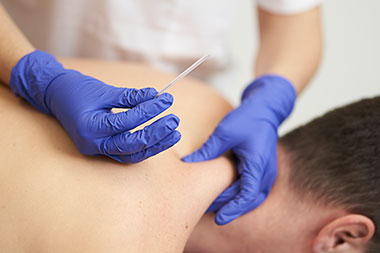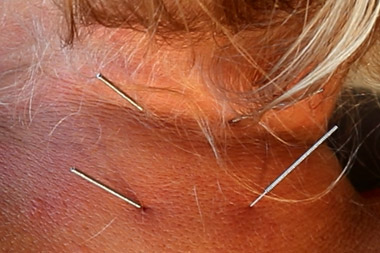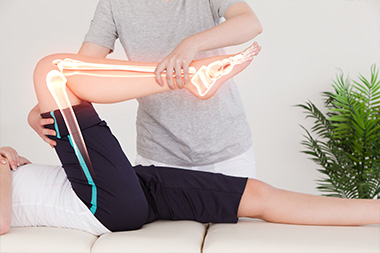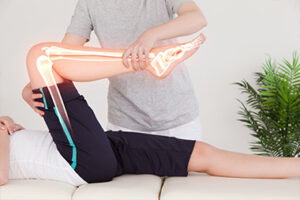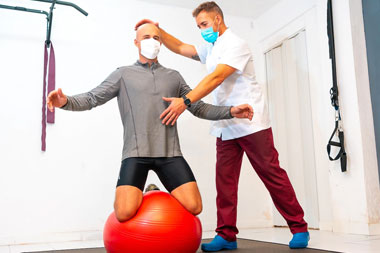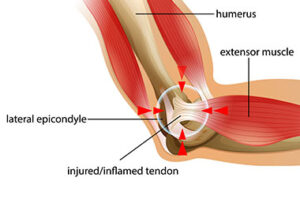
Tennis elbow treatment at home – What is it and how physiotherapy can help?
Physiotherapy is an integral part of tennis elbow treatment. Tennis elbow is a type of tendinitis — swelling of the tendons — that causes pain in the elbow and arm. These tendons are bands of tough tissue that connect the muscles of your lower arm to the bone. Despite its name, you can still get tennis elbow even if you’ve never been near a tennis court. Instead, any repetitive gripping activities, especially if they use the thumb and first two fingers, may contribute to tennis elbow. Tennis elbow is the most common reason that people see their doctors for elbow pain. It can pop up in people of any age, but it’s most common at about age 40.
Tennis elbow usually develops over time. Repetitive motions — like gripping a racket during a swing — can strain the muscles and put too much stress on the tendons. That constant tugging can eventually cause microscopic tears in the tissue. It can also affect people with jobs or hobbies that require repetitive arm movements or gripping.
Symptoms of Tennis Elbow:
The main part of tennis elbow treatment is checking for the symptoms. The symptoms of tennis elbow include pain and tenderness in the bony knob on the outside of your elbow. This knob is where the injured tendons connect to the bone. The pain may also radiate into the upper or lower arm. Although the damage is in the elbow, you’re likely to hurt when doing things with your hands.
Tennis elbow is similar to another condition called golfer’s elbow, which affects the tendons on the inside of the elbow. To diagnose your tennis elbow, your doctor will do a thorough exam. They will want you to flex your arm, wrist, and elbow to see where it hurts. You may also need imaging tests, such as an X-ray or MRI (magnetic resonance imaging) to diagnose tennis elbow or rule out other problems.
Why Physiotherapy for tennis elbow treatment?
The goal is to improve the strength and flexibility of your forearm muscles so you won’t be bothered with tennis elbow again. Your physical therapist may also teach you ways to change your tennis stroke or other activity that is causing your elbow troubles which is an integral part of tennis elbow treatment. Physiotherapy can also help improve blood flow to the tendons, which don’t get the same level of blood and oxygen supply as muscles normally receive
Exercises that improve blood flow will improve healing, too.
Pain Relief:
Your therapist will start with pain relief, then show you exercises that stretch and strengthen your muscles.
Exercises:
Once the pain eases during your tennis elbow treatment, you’ll move onto exercises. How long it takes to get better depends on the severity of your symptoms. It could take up to 8 weeks or even longer to see results. This isn’t a “no pain, no gain” exercise situation. If you’re hurting, stop. Pushing through it only makes it worse. With the exercises below, the number of reps and how often to do them is just a guideline. Follow your therapist’s advice and program. And listen to your body. If 10 reps hurt, start with five. If doing them every day feels like a strain, try every other day and work your way up.
After Your Program Is Over:
Once your elbow is pain-free and your backhand is better than ever, you should continue to keep your muscles strong and flexible. That’s because everyday activities don’t keep your muscles as strong and flexible as they should be to avoid sports injuries. Talk to your therapist or doctor about the best ways to continue keeping your elbow working at its best.
Recovering from Tennis Elbow:
Of course, what you really want to know is when you can get back to your regular activities after having tennis elbow. That depends on your individual case and the extent of the damage to the tendon. People heal at different rates. Whatever you do, don’t rush your recovery. If you start pushing yourself before your tennis elbow is healed, you could make the damage worse.
How to Prevent Tennis Elbow:
The key to preventing tennis elbow is to avoid overuse. Stop if you feel any elbow pain during an activity. You may also bring on tennis elbow by using the wrong equipment, like a golf club or tennis racket that is too heavy or that has a grip that is too large. Bad technique — like using the wrong posture for a swing — can also lead to tennis elbow. You should also: Stretch and warm up before any sport or activity that will exercise your elbow or arm. And Ice your elbow after exercise.


